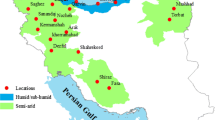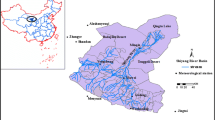Abstract
As one of the most important climatic variables, annual evapotranspiration (E) reflects the complex interactions between atmosphere, vegetation, soil and hydrological process at global and regional scales. It is largely determined by potential evapotranspiration (E 0 ) and precipitation (P). Aridity index (E 0 /P) which can be defined as the ratio of annual potential evapotranspiration to annual precipitation, can be used to represent annual evapotranspiration. As result it has become an important indicator to assess water-related climate change. This study utilizes the aridity index to reveal the recent climate change patterns in the Lancang River Basin, China. A new non parametric estimator of climate elasticity has also been developed. Using the daily meteorological records (1961–2005) of precipitation, air temperature, wind speed, relative humidity and sunshine hours from 35 stations, changes in spatial and temporal characteristics of P, E 0 , E, and E 0 /P are analyzed. The results reveal some important new findings, which can be summarized as: (a) new findings show that the spatial distribution of, and the correlation coefficients between P, E 0 , E, and E 0 /P possess strong latitude zonality; (b) high consistency in the temporal variation of P and E has been detected. The main periodicity of the E and E 0 /P series varies greatly for the three sub basins, and an anti-phase relationship between them has also been found; (c) our newly developed nonparametric estimator of climate elasticity can be successfully used in assessing the sensitivity of climate system. Climate elasticity of E in relation to E 0 and P increases for most of the regions in the study area, suggesting that E becomes more sensitive to changes in the corresponding climatic variable during the study period. The study demonstrates the importance of the aridity index in the water-related climate change studies which has been neglected for a long time by most hydrologists and managers.










Similar content being viewed by others
References
Allen RG, Pereira LS, Raes D, Smith M (1998) Crop evapotranspiration—guidelines for computing crop water requirements. FAO Irrigation and Drainage Paper 56 FAO
Arora VK (2002) The use of the aridity index to assess climate change effect on annual runoff. J Hydrol 265:164–177
Budyko MI (1974) Climate and life. Academic, New York
Darshana, Pandey A, Pandey RP (2013) Analysing trends in reference evapotranspiration and weather variables in the Tons River Basin in Central India. Stoch Environ Res Risk Assess 27(6):1407–1421
Gerrits AMJ, Savenije HHG, Veling EJM (2009) Analytical derivation of the Budyko curve based on rainfall characteristics and a simple evaporation model. Water Resour Res 45:W04403. doi:10.1029/2008WR007308
He DM (1995) Analysis of hydrological characteristics in Lancang-Mekong river. Yunnan Geogr Environ Res 7(1):58–74
Jevrejeva S, Moore JC, Grinsted A (2003) Influence of the arctic oscillation and El Niño-southern oscillation (ENSO) on ice conditions in the Baltic Sea: the wavelet approach. J Geophys Res 108(D21):4677. doi:10.1029/2003JD003417
Koster RD, Suarez MJ (1999) A simple framework for examining the interannual variability of land surface moisture fluxes. J Clim 12:1911–1917
Li B, Li LJ, Qin YC et al (2011) Impacts of climate variability on streamflow in the upper and middle reaches of the Taoer River based on the Budyko hypothesis. Resour Sci 33(1):70–76 (in Chinese)
Li B, Su H, Chen F (2012) The changing pattern of droughts in the Lancang River Basin during 1960–2005. Theor Appl Climatol. doi:10.1007/s00704-012-0658-2
Li B, Su H, Chen F (2013) The changing characteristics of drought in China from 1982 to 2005. Nat Hazards. doi:10.1007/s11069-013-0649-3
Liang LQ, Li LJ, Liu Q (2011) Precipitation variability in Northeast China from 1961 to 2008. J Hydrol 404:67–76
Liu Q, Yang ZF (2010) Quantitative estimation of the impact of climate change on actual evapotranspiration in the Yellow River Basin, China. J Hydrol 395:226–234
McVicar TR, van Niel TG, Li LT, Hutchinson MF, Mu XM, Liu ZH (2007) Spatially distributing monthly reference evapotranspiration and pan evaporation considering topographic influences. J Hydrol 338:196–220
McVicar TR, Roderick ML, Donohue RJ (2012) Global review and synthesis of trends in observed terrestrial near-surface wind speeds: implications for evaporation. J Hydrol 416–417:182–205
Ol’dekop EM (1911) On evaporation from the surface of River Basin. Transactions on Meteorological Observations, Lur-evskogo. University of Tartu, Tartu, Estonia (in Russian)
Pike JG (1964) The estimation of annual runoff from meteorological data in a tropical climate. J Hydrol 2:116–123
Reddy MJ, Ganguli P (2013) Spatio-temporal analysis and derivation of copula-based intensity–area–frequency curves for droughts in western Rajasthan (India). Stoch Environ Res Risk Assess 27(8):1975–1989
Sankarasubramanian A, Vogel RM, Limburner JF (2001) Climate elasticity of streamflow in the United States. Water Resour Res 37:1771–1781. doi:10.1029/2000WR900330
Schaake JC (1990) From climate to flow. Climate change and U.S. water resources. Wiley, New York, pp 177–206
Sehreiber P (1904) über die Beziehungen zwischen dem Niederschlag undder Wasserfürung der Flübe. Mitteleuropa Zeitschrift fur Meteorologie 21:441–452
Shehata WM, Amin AA (1997) Geotechnical hazards associated with desert environment. Nat Hazards 16:81–95
Torrence C, Compo GP (1998) A practical guide to wavelet analysis. Bull Am Meteorol Soc 79:61–78
Velpuri NM, Senay GB (2013) Analysis of long-term trends (1950–2009) in precipitation, runoff and runoff coefficient in major urban watersheds in the United States. Environ Res Lett 8:24020–24026
Zhang L, Dawes WR, Walker GR (2001) The response of mean annual evapotranspiration to vegetation changes at catchment scale. Water Resour Res 37:701–708
Zhang Q, Xu CY, Jiang T (2007) Possible influence of ENSO on annual maximum streamflow of Yangtze River, China. J Hydrol 333:265–274
Zhang D, Liu XM, Hong HY (2013a) Assessing the effect of climate change on reference evapotranspiration in China. Stoch Environ Res Risk Assess 27(8):1871–1881
Zhang D, Liu XM, Liu CM, Bai P (2013b) Responses of runoff to climatic variation and human activities in the Fenhe River, China. Stoch Environ Res Risk Assess 27(6):1293–1301
Zhao QH, Liu SL, Deng Li, Dong SK, Yang JJ (2012) The effects of dam construction and precipitation variability on hydrologic alteration in the Lancang River Basin of southwest China. Stoch Environ Res Risk Assess 26(7):993–1011
Zheng H, Zhang L, Zhu R, Liu C, Sato Y (2009) Responses of streamflow to climate and land surface change in the headwaters of the Yellow River Basin. Water Resour Res 45:W00A19. doi:10.1029/2007WR006665
Acknowledgments
This study was made possible by Grants from the National Natural Science Funds of China (41101342) and the Hundred Talents Program of Chinese Academy of Sciences (Y2ZZ02101B), and the Comparative Study on Global Environmental Change Using Remote Sensing Technology (41120114001), the National Natural Science Foundation of Major International (regional) Collaborative Research Project.
Author information
Authors and Affiliations
Corresponding author
Rights and permissions
About this article
Cite this article
Li, B., Chen, F. Using the aridity index to assess recent climate change: a case study of the Lancang River Basin, China. Stoch Environ Res Risk Assess 29, 1071–1083 (2015). https://doi.org/10.1007/s00477-014-0998-9
Published:
Issue Date:
DOI: https://doi.org/10.1007/s00477-014-0998-9




